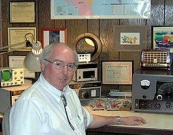On the Road with an ABIP Inspector Part 3 – Main Studio Gear, Tower Color, and More

[August 2013] Here is another in our continuing series showing how the Alternate Broadcast Inspection Program works.
New Mexico ABIP Inspector Mike Langner gives us a peek over his shoulder at some of the issues he sees as he does his inspections, which might give you some ideas on things that might need checking at your facility.
Over the years since it was put into operation, The Alternate Broadcast Inspection Program (ABIP) has become a win-win situation for broadcasters who really want to operate in the best possible way.
Under an agreement between the state broadcast associations and the FCC, a station that passes the ABIP inspection will not be inspected by any FCC agents for three years.
If an agent does come to a station and sees the certificate hanging in the lobby, they will simply say “good day” and leave. The only exception would be if the agent is responding to a specific complaint, such as if the station were causing interference or prohibiting viewing of the Public Inspection File.
The goal of the program is to help stations feel secure, knowing they are in compliance – and be free from big fines and large legal bills.
As I go around, I often find that the “fresh eye” will locate problems that can be fixed quickly and without any huge expense in time or money so the station can get back to the business of broadcasting.
Where Is This Station?
As with the forest and the trees, often it is the little things that escape notice until an outsider comes and looks.
For example, one large group of stations had placed their Public Inspection Files on a computer for the public to use.
Unfortunately, instead of the computer containing all the files for the stations sharing the same Main Studio building in the local Albuquerque market, someone had loaded a few wrong data files.
As a result, one of the stations had no Public Inspection File in the computer.
It was replaced instead by the file for one of the chain’s stations which is located several thousands of miles away was in its place!
Under the ABIP, the station just had to correct the problem – which they did – and their certifycate of compliance was issued. No muss, no fuss. There were no complaints, no NOVs (Notices of Violation), no need to involve the FCC nor any lawyers.
As I said a win-win.
Drawing the Right Lines
Then there was the station where a coverage map, as required, was in the Public Inspection File. However, it appeared to have been created by the sales department.
Rather than being based on technology and math, this map showed lots more coverage than the station actually had. On the other hand, since none of the contours were labeled, I guess the map was twice meaningless!
Either way, a quick discussion of what kind of map was required under the FCC Rules and Regulations put this station on the path to a legal coverage map that satisfied the FCC and the sales department.
We Had It the Last Time We Were There…
One of the radio stations I inspected had its Main Studio in a janitorial supply room in a hotel in the actual community of license.
Legal enough, so far.
Program origination equipment is required at the Main Studio, of course, and, sure enough, they had an STL microwave, a little console, and a microphone into which someone could speak. Well, actually, they had a microphone connector. Someone had stolen the microphone who knows how long ago.
Once again, having an ABIP inspection saved the station an NOV and an expensive interaction with the FCC. The inspection more than paid for itself several times over.
The Wrong Touch Up
Not too long ago I went to a station which had had its tower painted. The steel was covered, but there was a minor problem.
The tower crew, no doubt the lowest bidder, started painting at the top, which is the usual procedure. Unfortunately they ran out of paint before they finished, so they dispatched someone to run off to Home Depot and purchase some more orange paint.
From what I could tell it was highway safety orange. It was certainly not the proper FAA Aviation Orange as required by both the FAA and the FCC. (Click here to see Ed Trombley’s discussion on paint, painters, a link to the FAA specs and other good information.)
After I showed the broadcast company my paint color chart, they had the tower re-painted with the correct color. Want to buy your own chart? They are available from Hale Color Charts, Inc. at 800-777-1225.
So much for using what I presume had been the lowest bidder. But the cost would have been much higher if the FCC had done the inspection.
When the Color Does Not Matter
A different station that I visited was not required by its FCC license terms or by the FAA to place any lights or painting on their tower. Yet their tower was completely painted.
It looked great! It was, however, painted sky blue and dirt brown – blue top sections, brown bottom. And perfectly legal.
You see, the local city council in that station’s community is quite anti-tower, so the broadcaster was required by the city to paint the top sections sky blue and the bottom brown to “hide” the tower. Now, if somebody will just perfect the Harry Potter “invisibility cloak!”
– – –
Mike Langner is a long time engineer and station owner in the Albuquerque market, now serving as an ABIP Inspector. Contact Mike at mlangner@swcp.com
– – –
Do you have a question about inspections? Contact Mike at mlangner@swcp.com
